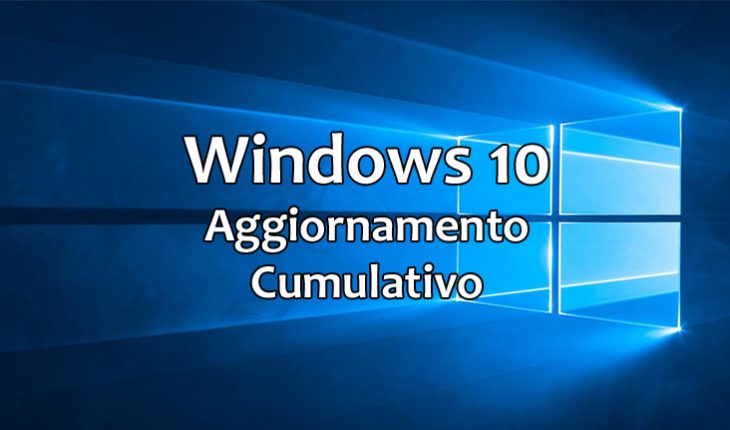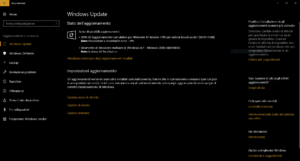Microsoft ha dato il via alla distribuzione dell’Aggiornamento Cumulativo di Windows 10 relativo al mese di febbraio 2018. Scaricabile come al solito tramite Windows Update, sui computer con Windows 10 Fall Creators Update (v1709) viene identificato con il nome in codice KB4074588 e una volta installato porta il sistema alla Build 16299.248.
Sulle altre versioni di Windows 10, l’Aggiornamento Cumulativo è identificato come riportato nell’elenco qui sotto:
- Creators Update (v1703): KB4074592 – Build 15063.909
- Anniversary Update (v1607): KB4074590 – Build 14393.2068
- November Update (v1511): KB4074591 – Build 10586.1417
- Initial release (1507): KB4074596 – Build 10240.17770
Di seguito il changelog ufficiale dell’update KB4074588 per PC e tablet:
- Addresses issue where child accounts are able to access InPrivate mode on ARM devices even though their browsing and search history is sent to their parents. This occurs only on Microsoft accounts belonging to children that are managed using the Microsoft Family service and for which parents have enabled activity reporting. This applies to Microsoft Edge and Internet Explorer.
- Addresses issue with docking and undocking Internet Explorer windows.
- Addresses issue in Internet Explorer where pressing the delete key inserted a new line in input boxes in an application.
- Addresses issue in Internet Explorer where selected elements wouldn’t update under certain circumstances.
- Addresses issue where some users may have experienced issues logging into some websites when using third-party account credentials in Microsoft Edge.
- Updates time zone information.
- Addresses issue with browser Compatibility View settings that occurs during updates.
- Addresses issue where, in certain hardware configurations, the frame rates of DirectX Games were unintentionally limited to a factor of the display’s vertical synchronization.
- Addresses issue that causes delays when switching keyboard languages using Alt+Shift.
- Addresses issue where surround sound audio endpoints reverted to stereo after restarting.
- Improves and reduces conditions where certain Bluetooth keyboards drop keys during reconnection scenarios.
- Corrects mouse delays for devices that incorrectly report the battery level status.
- Addresses issue where MMC application snap-ins—such as Services, Local Policy Admin, and Printer Management—fail to run when Windows Defender Application Control (Device Guard) is turned on. The error is “Object doesn’t support this property or method”.
- Prevents use of the Pre-production Onesettings endpoint for Windows Setup when test signing is enabled.
- Addresses issue where installations of Windows Server, version 1709 are not automatically activated using the Automated Virtual Machine Activation (AVMA) feature on Hyper-V hosts that have been activated.
- Addresses issue with the Auto-register Inbox templates feature for UEV where the Scheduled Task didn’t have the proper trigger.
- Addresses issue where the App-V client didn’t read the policy for SyncOnBatteriesEnabled when the policy was set using a Group Policy Object (GPO).
- Addresses issue where the Supported On field for the Enable App-V Client policy is blank in the Group Policy editor.
- Addresses issue where the user’s hive data in the registry is not maintained correctly when some App-V packages belong to the connection group.
- Provides additional logging for administrators to take action, such as picking a proper configuration for their App-V package, when there are multiple configuration files for a single package.
- Addresses issue with App-V packages that aren’t compatible with registry virtualization using kernel containers. To address the issue, we changed the registry virtualization to use the earlier (non-container) method by default. Customers who would like to use the new (kernel container) method for registry virtualization can still switch to it by setting the following registry value to 1: Path: HKEY_LOCAL_MACHINE\SOFTWARE\Microsoft\AppV\Client\Compatibility, Setting: ContainerRegistryEnabled, DataType: DWORD
- Security updates to Microsoft Scripting Engine, Microsoft Edge, Internet Explorer, Microsoft Windows Search component, Windows Kernel, Windows Authentication, Device Guard, Common Log File System driver, and the Windows storage and file systems.
Se il vostro PC non ha già fatto da sé, potete scaricare ed installare questo update manualmente accedendo a Impostazioni, Aggiornamento e Sicurezza, e cliccando o toccando la voce “Verifica disponibilità aggiornamenti”.
Ricordiamo che se desiderate confrontarvi con altri utenti su un differente argomento, il luogo migliore per farlo è questa sezione dedicata del nostro Nokioteca Forum.



Grazie, aggiornerò quanto prima.
Per mobile niente??
Windows Mobile 10 Production Bundle – OS 10.0.14393.2068 update for all mobile phone devices
Ultima modifica: 14/02/2018
Dimensione: 2972,2 MB
Descrizione: Windows 10 Mobile (10.0.14393.2068) – Questo aggiornamento può contribuire a migliorare ancora di più il tuo telefono
http://it.tinypic.com/r/2rp5zrr/9
@yepp 2972,2 mb sono tantissimi. Cosa è un treno?
Ovviamente Windows Update restituirà un “pacchetto” contenente solo i cambiamenti che sono stati fatti dall’ultima volta che il tuo telefono è stato aggiornato, non tutta la build
E per Smartphone?
E’ in arrivo…
15254.249
15063.909
14393.2068
Rimanete sintonizzati!
@yepp
Ma quando?? Ma smettiamola una volta per tutte. Sono ridicoli! Fiducia prossima allo zero!!
Non è mica la prima volta che le build per mobile arrivano il giorno dopo. Abbiate fede che le build mobile arriveranno per tutti (FCU, CU e AU).
Grazie anche da parte mia. Controllerò PC e Windows Phone 🙂
Aggiornamento fatto
Dopo l’aggiornamento Windows update dice che é aggiornato ma se vado nella cronologia degli aggiornamenti chiede ancora di riavviare per completare l’aggiornamento
Ho trovato questa mattina quello per il mio lumia 830. Installato con successo.
@giacomo54/830 è di 2962,2 mb come dice yepp?
Anche per Smartphone, lumia 930 aggiornato stamattina
Boh il mio 650 non rileva ancora nulla
Stasera sarà il tuo turno
A stasera!
io ho problemi di riavvio improvviso, con questo aggiornamento di rivolve il problema? grazie
@Johhny tanto per cambiare come se non ci fossere mai stati riavvii. Il tel ti si blocca con schermo nero? E a volte per sbloccare devo togliere la batteria ma ancora aggiorno io
perdonatemi non ho specificato che il problema ce l’ho al pc, ho un processore amd a10 5800k
Fiondatevi a controllare gli aggiornamenti…
“2018-02 Aggiornamento per Windows 10 Version 1709 per dispositivi Phone basati su arm”
Come promesso, ecco la build di W10M FCU!?
=> Lunga vita a W10M?
Trovato, Lumia 1520
@yepp
Ok, stavolta hai fatto centro. Peccato per i pdf con edge. Visto che sapevano del problema, potevano rinviare a questo punto.
Il fix per i PDF è in arrivo. C’erano troppe cose importanti in questa build per ritardarla
Lumia 950 sta aggiornando
Trovato! Lumia 1520
A me il pc non lo trova come la volta scorsa…. Ho fatto in manuale ma è normale? Cosa può essere?
Problemi durante l’installazione del 14393.2068…sapete qualcosa? Lumia 830